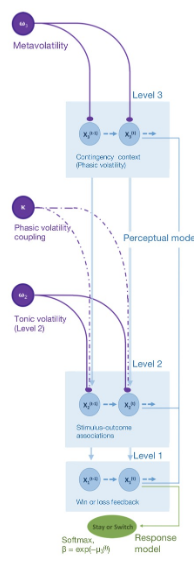Computational

We believe that brains implement hierarchical predictive coding - specifying predictions top-down and prediction errors bottom up. Inferential conclusions - about what must be happening in order for inputs to make sense - are a precision-weighted trade-off between those prior predictions and prediction errors. Precise prediction errors demand belief updating - perhaps leading to new delusions. For example, a surprising world demands explanation, and we often turn to powerful and mysterious others to explain that ineffability. This is captured in our data as a relationship between prior beliefs about volatility in a task and the severity of self-reported paranoia and conspiracy thinking. Precise priors can overwhelm the evidence - perhaps culminating in hallucinations, indeed, we can estimate perceptual prior weighting during our tasks, and we find it is elevated in people who hallucinate. We test these hypotheses by fitting behavioral data to computational models - including but not limited to the Hierarchical Gaussian Filter - estimating their parameters and relating those estimates to the presence and profundity of delusions and hallucinations.




